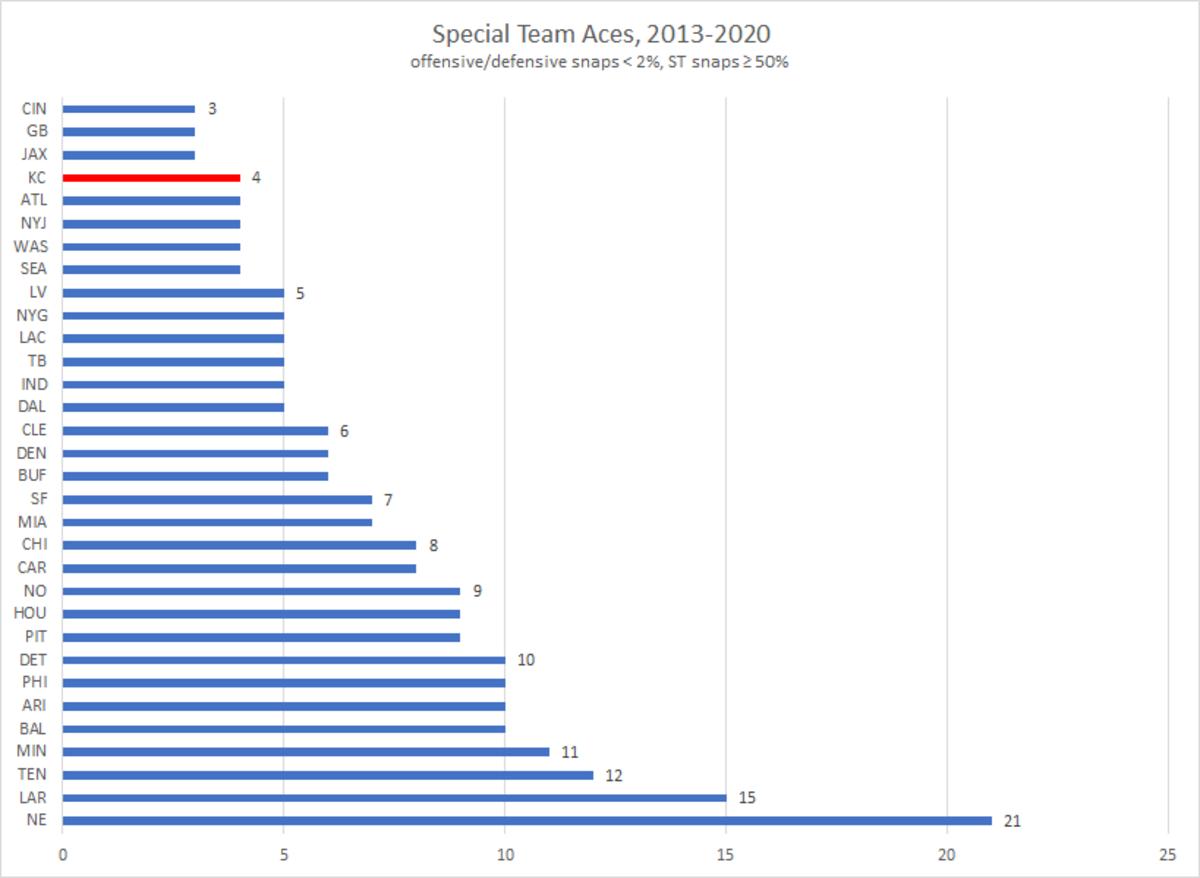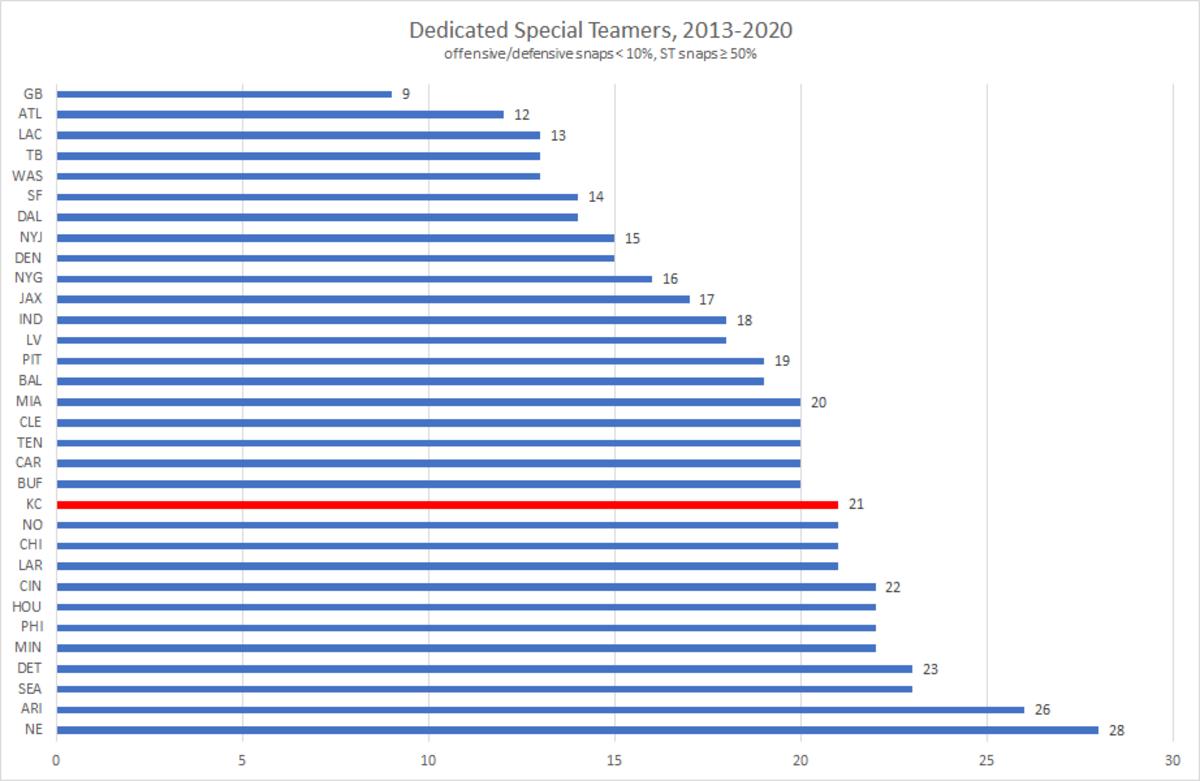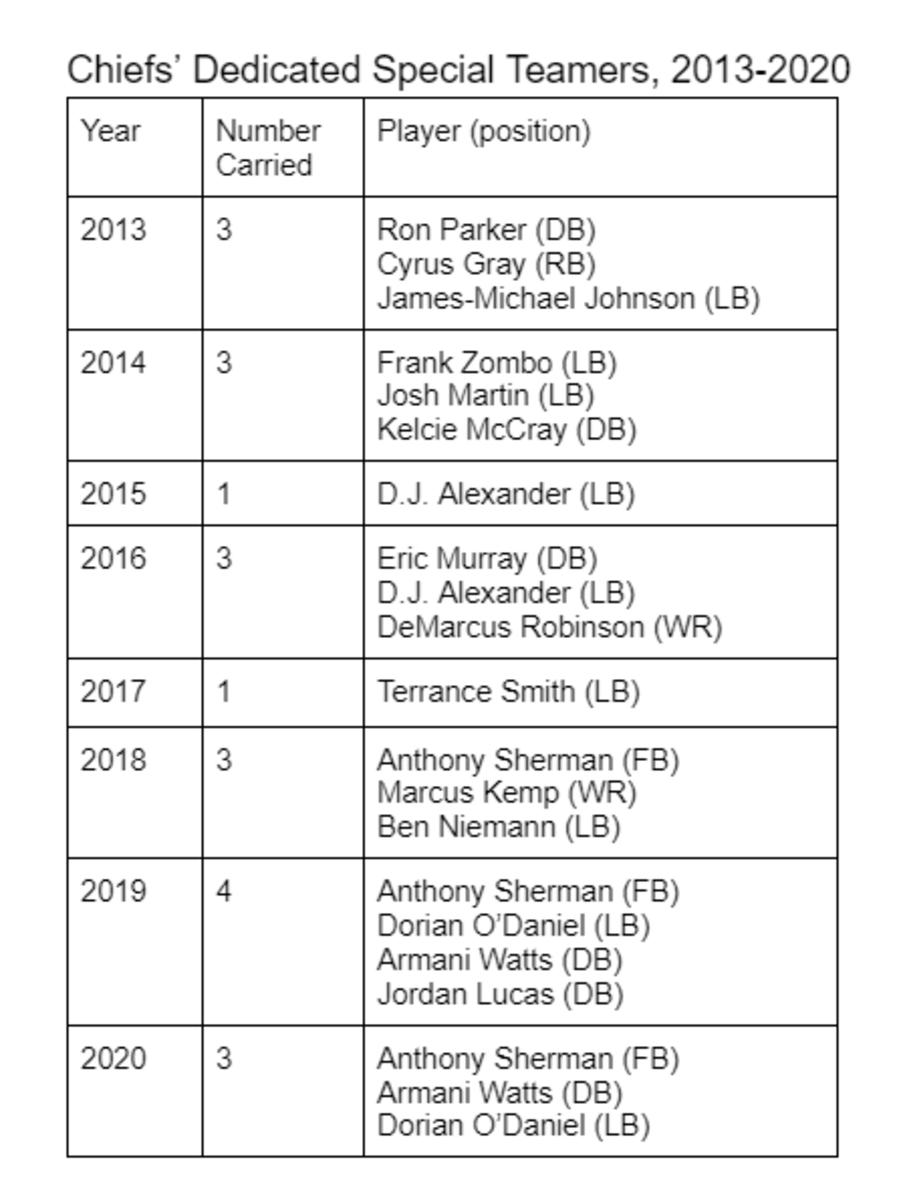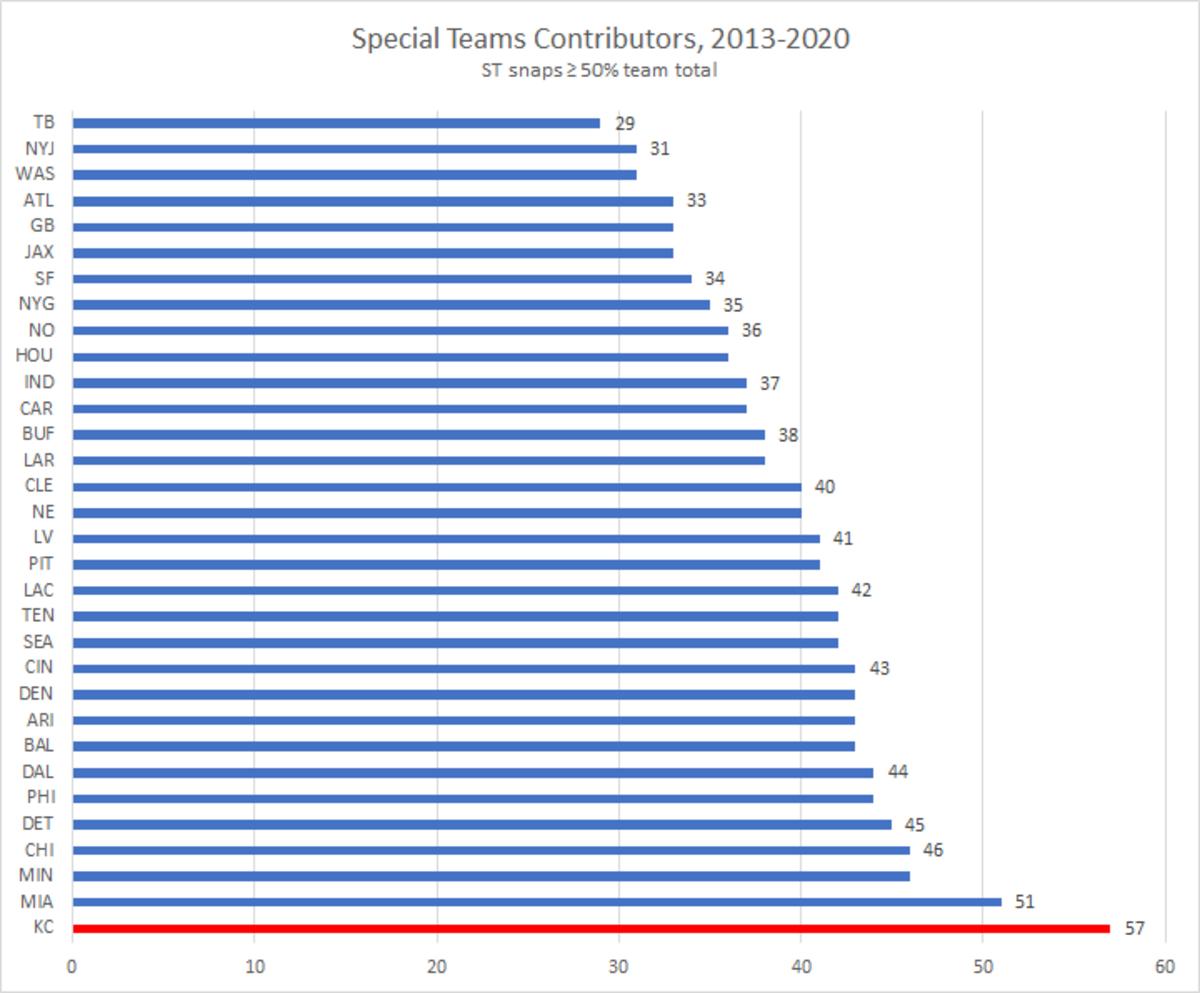Hustle and Toub: How Much Do Special Teams Players Matter to the Chiefs?
The Chiefs have announced their official 53 man roster for the 2021 NFL season. With a gaggle of young and seemingly promising players failing to make the initial cut – 2021 fifth-round pick Cornell Powell, early camp standout Devon Key, 2020 draft pick BoPete Keyes, and others – Chiefs fans are asking that question, again, for the eighth year in a row.
How much say does Dave Toub have in choosing the final 53?
Toub, the Chiefs’ special teams coordinator, is the longest-tenured assistant on head coach Andy Reid’s staff, having joined Reid in Kansas City just ten days after Big Red was hired in January 2013. Toub has the reputation of being one of the best special teams coaches in NFL, a reputation well-deserved by at least one metric: according to Football Outsiders’ DVOA metric, Toub’s unit has been top 10 in seven of his eight seasons in KC, including four finishes in the top two, though his worst finish, 17th, came last year.
Toub also has a reputation (deserved or not) as a shadow GM. Whenever a camp darling like Key or a prospect like Powell is cut from the Chiefs’ 53-man roster – usually in favor of an uninspiring special teamer like Marcus Kemp, Dorian O’Daniel, or Ben Niemann (before he became an uninspiring starting linebacker) – the Kingdom is quick to blame Toub’s influence.
But how much say does Toub have, really, over the Chiefs’ roster? In an attempt to answer that question, we turned to snap count data compiled by Football Outsiders.
Every NFL team plays with a 53 man roster, but not every team utilizes roster space the same way. Every NFL roster will include 11 offensive starters, 11 defensive starters, and three specialists – a kicker, punter, and long snapper – but the remaining 28 roster spots are a mixed bag of rotational players, redshirting rookies, “break glass in case of emergency” backups and depth pieces.
It's from this mixed bag of 28 that the majority of special teams snaps are drawn, and where a special teams coach with sway might conceivably influence roster decisions. To test the hypothesis that Toub wields more influence over the Chiefs’ 53 than other special teams coaches across the league, we looked at three data sets.
First, we looked at Special Teams Aces – players who play almost exclusively on special teams, without making significant contributions on offense or defense.
Next, we considered Dedicated Special Teamers — players who, while making nominal contributions on offense or defense, primarily play on special teams.
Finally, we looked at Special Teams Contributors –players who logged significant snaps on special teams, regardless of their contribution on offense or defense. In each of these categories, we excluded specialists from consideration, so these numbers do not include kickers, punters, or long snappers.
Common sense dictates that the less a player contributes on offense or defense, the more influence a special teams coordinator must necessarily exert to get that player onto the 53-man roster, and, further, that the more players a team utilizes heavily on special teams, the more influence a special teams coordinator must necessarily have over roster decisions. What we are looking for in this data is evidence that the Chiefs either:
1) Utilize dedicated special teamers, including “aces,” at a higher rate than the rest of the league, OR
2) Utilize more contributors on special teams than the other teams in the league.
The first data set we looked at was the number of Special Teams Aces employed by the Chiefs and around the NFL since 2013. We define Special Teams Ace as a player who plays 50% or more of his team’s special teams snaps, but fewer than 2% of offensive or defensive snaps. In other words, a player who is on the roster solely for his contributions on special teams - and therefore, necessarily, as a concession to the special teams coach. The following chart shows the number of special teams aces for each NFL team since 2013:

As the chart clearly shows, the Chiefs actually employ far fewer special teams aces than the average NFL team – just four since 2013. In 2015, rookie linebacker D.J. Alexander logged 344 special teams snaps (77.1%) while playing just nine on defense (.8%). The following year, rookie wide receiver Demarcus Robinson played just six offensive snaps (.6%) but 272 on special teams (60.6%).
In 2019, second-year linebacker Dorian O’Daniel played 292 snaps on special teams (69%), and in 2020, 218 (50%) before suffering a season-ending injury in Week 12 against Tampa. O’Daniel logged a combined total of 14 defensive snaps over those two seasons, less than 1% of the team total.
While the data demonstrates that the Chiefs employ very few special teams aces relative to the league as a whole, the very existence of Dorian O’Daniel represents some support for the Toub-as-influencer hypothesis. Demarcus Robinson’s rookie role as special teams ace was clearly not deliberative, as he saw his ST snap share drop markedly and permanently after his rookie year (perhaps unsurprisingly, given Toub’s recent comment that Robinson "drives him nuts.").
Alexander remained a special teams fixture in 2016 but saw his role on defense grow slightly; he was then traded to Seattle for Kevin Pierre-Louis in 2017. O’Daniel, on the other hand, played 302 defensive snaps in his rookie year (2018) – a far larger contribution than either Robinson or Alexander –before dropping into a special-teams-only role each of the past two seasons. He seems set to reprise that role this year as he made the Chiefs’ 53.
O’Daniel’s roster spot in 2021 can fairly be attributed to Toub’s machinations, but Toub getting one player of 53 is hardly proof that Toub wields considerable influence over personnel. To further test that hypothesis, we next look at the Chiefs’ utilization of Dedicated Special Teamers, which we define as a player who plays 50% or more of his team’s special teams snaps, but fewer than 10% of offensive or defensive snaps.
These are players who, unlike a special teams ace, are expected to play snaps on offense or defense in a situational role or in case of injury to a starter, but whose primary contribution will still be on special teams. Thus, these are still players who we would expect a special teams coach to have considerable input on when the final cuts are being decided. The below chart shows the number of dedicated special teamers for each NFL team since 2013:

The Chiefs, with 21 dedicated special teamers rostered since 2013, are slightly above the NFL average but hardly stand out. Thirteen of the NFL’s 32 teams, including the Chiefs, carried between 20 and 22 dedicated special teamers during this period.
This chart includes all special teams aces, who by definition are also “dedicated special teamers,” so it is worth noting the Chiefs’ movement from near bottom in “aces” to middle-of-the-pack in “dedicated special teamers.” While these dedicated special teamers are making nominal contributions on offense or defense, we can safely assume that Toub has considerable influence in picking these players to the 53, since the bulk of their contributions are on special teams. The Chiefs’ dedicated special teamers under Toub are outlined below:

Toub’s contributions to each of these players making the 53 are a matter of conjecture. For instance, the Chiefs have carried a fullback on their roster every season since Toub became special teams coordinator in 2013, and that fullback (Anthony Sherman from 2013 to 2020, now Michael Burton) has always played more than 50% of the special teams snaps. Of course, 2013 is also the year that Andy Reid took over as head coach and offensive play-caller, and hired Toub.
The decision to roster a fullback, practically a relic in the modern NFL, has almost certainly been Reid’s, not Toub’s – regardless of how much the Chiefs’ fullback contributes on special teams. And Anthony Sherman became a “dedicated special teamer,” under our definition, not because of an increasing role on special teams, but because of a declining role on offense: after logging between 16.6 to 35.7% of offensive snaps each year from 2013 to 2017 in an attack designed for Alex Smith, Sherman’s share dropped to under 10% after Patrick Mahomes became the starter in 2018.
Likewise, much-maligned linebacker Ben Niemann qualified as a “dedicated special teamer” as a rookie in 2018, but his regrettably growing role on defense has prevented him from qualifying since. How much thanks does a player like Niemann – whose play on defense is hardly worthy of a roster spot – owe to Toub? Is it Niemann’s ability on special teams that keeps him hanging on the 53, or is it the Chiefs’ lack of depth at linebacker?
It might not be possible to answer these questions on the individual player level, but we looked at one final data set in an effort to prove or disprove our Toub hypothesis. This final set consists of Special Teams Contributors, which we define as a player who plays 50% or more of his team’s special teams snaps, regardless of his snap share on offense or defense.
These players may play a significant role on offense or defense, as did 2019 Daniel Sorensen, who played 51.3% of KC’s defensive snaps while taking 67.1% of snaps on special teams, or 2017 Demetrius Harris, who combined his 65% snap share on special teams with a 47.1% snap share on offense. This player’s spot on the 53 might not be solely because of his contributions to special teams, as with a special teams ace or dedicated special teamer.
But with the team expecting the player to log significant special teams snaps, that element of his game must necessarily play a part, whether slight or substantial, in whether or not he makes the cut. The below chart shows each team’s number of special teams contributors since 2013:

Here, in this final data set, we have the strongest statistical argument in support of the Toub-as-shadow-GM theory. The Chiefs have more players getting a 50% snap share on special teams than any other team in the NFL, and it isn’t particularly close. The Chiefs have nearly 25% more players getting 50% or more of their special teams snaps than the two teams in third place, Chicago and Minnesota. They have used almost twice as many special teams contributors as Tampa Bay.
Simply put, the Chiefs rely on more of their 53-man roster to contribute significant snaps to special teams than any other team.
And because the Chiefs rely on more players to contribute to special teams than any other team, it would be reasonable to conclude that the Chiefs’ special teams coordinator, Dave Toub, for better or for worse, wields more influence over the final 53 than any of his peers.
